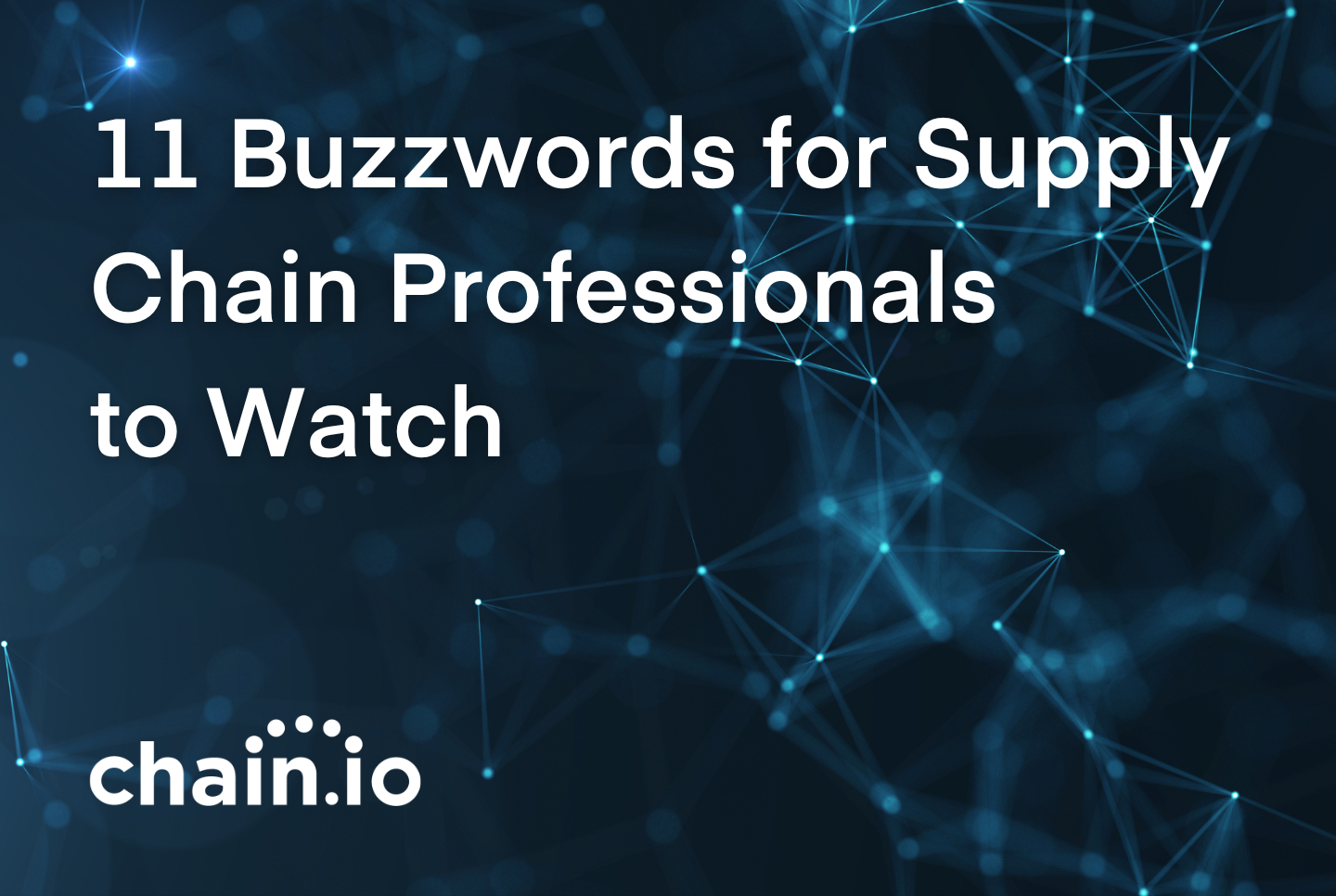
Buzzwords in the supply chain technology space change about as often as the technology itself. Though it can be tough to keep track from week to week, it's important to stay current with the industry's focus to know how your business may need to adapt.
In the last few years, many buzzwords emerged within the supply chain technology space, but eleven have stuck around and are even starting to be widely used across the industry. Take an insider's look at how these words can be used, as well as how they should be applied within your own IT infrastructure.
1. AI
What is AI?
Artificial intelligence is simply defined as computers that can use information to make decisions.
Reality Check
The hype is real. AI is on a path to transform almost every business process.
The science behind AI is really hard though, and still expensive and relatively inaccessible. As more companies leverage this technology to solve their supply chain issues, the cost is likely to come down.
If you’re a large freight forwarder, shipper, or software provider, chances are you are already investing in artificial intelligence. If you are a medium to small size organization, start looking for AI enabled functionality in the software you buy.
2. Big Data
What is Big Data?
Simply put, big data is a large and complex collection of data that your company produces or collects and uses to learn about trends in your business, or the supply chain and logistics industry.
Reality Check
Big data has been around for years, we just may have not realized it.
Big data is extremely valuable for your company, as it contains the potential for your company to improve your business processes and learn what your customers want from you in the future.
As a freight forwarder or shipper, your company should be collecting data at the lowest possible level of detail - every carton scan, flight, PO, and sku. You should also begin thinking of how to analyze and use this data to create new value.
3. Machine Learning
What is Machine Learning?
Machine learning is a key component of artificial intelligence. Computers have the ability to use data to learn your processes.
For example, if you give a computer all of your flight history data, it can accurately tell you whether the next flight will arrive on schedule.
Reality Check
Machine learning models are the precursor to artificial intelligence.
At a minimum, as you start collecting Big Data, you should start noticing trends and identifying what business questions you’d like answers to.
As a freight forwarder or shipper, the software vendors you choose moving forward will likely begin leveraging a machine learning strategy to improve their offerings.
4. APIs
What are APIs?
API, or Application Programming Interface, gives software applications the ability to talk to each other in real-time.
These enable many of the integrations we do at Chain.io.
Reality Check
APIs have already greatly accelerated the speed of business and the modernization of global supply chains. More customers are starting to request data be available to them in real time, and API’s will make this possible.
APIs aren’t about making your existing EDI faster, but rather about rethinking the way you exchange data at a much more granular level. You can enable customers to see inside your business in real time.
(Make sure your business processes are ready for transparency!)
5. Augmented Reality (AR)
What is AR?
Augmented reality enables you to overlay images on the real world. Think Google Glass for industrial use.
Reality Check
If you physically handle goods, AR can help you increase accuracy and speed where humans are still involved.
Think about a pick system where the user’s visor highlights the right item and can tell them if they pick up the wrong thing, or glasses that highlight exactly which containers need to be loaded from the warehouse in real-time.
6. Serverless
What is Serverless?
Serverless architecture is “the cloud,” on steroids. With this in place, your IT team no longer manages any servers and code runs directly on cloud providers like Amazon, Microsoft, Google, or IBM.
Reality Check
Serverless architecture has the potential to dramatically reduce IT overhead costs and vastly improve security for software providers.
Supply chain software companies that have in-house developers are likely already using or thinking of implementing a serverless structure, as it is a clear way to improve business.
7. Internet of Things (IOT)
What is IOT?
The internet of things describes physical objects with processing capabilities and the ability to connect and exchange information across the internet.
Tech like Nest Thermostats or container GPS tracking are all a part of the IOT.
Reality Check
For supply chain professionals involved in the physical handling of goods, you should develop a strategy for connecting your internet of things and your Big Data feeds so that you can be more informed of your overall operations and eventually empower your AI or Machine Learning efforts.
If you don’t physically handle goods, think about creating APIs to consume and leverage IOT data from your trading partners.
8. Blockchain
What is Blockchain?
Blockchain is a system of recording information that makes it difficult, if not impossible, to change. It is “fraud-proof.”
Reality Check
Blockchain is still widely being developed and implemented, but it's happening fast. While in development, there will likely be lots of money spent on solutions that don’t work well before industry standards can be established.
Blockchain offers a huge potential for improvements in customs clearance, proof of delivery notifications, letters of credit, and ethical sourcing compliance.
9. Visibility and Predictive Visibility
What is Visibility?
Visibility combines data from multiple sources to give you an accurate picture of where your freight is and when it will be at its destination.
This data is enabled by API’s, the internet of things, big data, and machine learning, and is vastly improving the information available to shippers and freight forwarding companies.
Reality Check
Visibility into shipments has always been a problem, mainly because there hasn’t been any. With recent delays and disruptions, retailers are wondering where their goods are but haven’t been given answers.
In just the last few years, there has been a massive improvement in visibility data thanks to the innovations of real-time transformation visibility providers (RTTVPs). In fact, the RTTVP market, led by companies like project44, Terminal49, and Vizion, is expected to grow to over $1 billion by 2024.
Learn More About Visibility10. Robotic Process Automation (RPA)
What is RPA?
Robotic Process Automation is software that creates bots to do repetitive tasks, like data entry, checking carrier sites, and more.
Reality Check
RPA has evolved greatly in the last few years, with advancements in tools that solve general supply chain issues and those that allow you to create your own bots to solve problems specific to your business.
If you don’t have the internal resources, using a pre-built bot to automate your processes can be helpful in starting to modernize your supply chain. If you have a dedicated team that can develop bots, try a custom RPA to help you overcome internal barriers.
11. Low Code
What is Low Code?
Low Code platforms allow non-programmers to build applications without needing to actually write code. They have visual drag and drop interfaces.
Reality Check
Low code tech has proven useful in a select few scenarios, but doesn’t seem to be the answer to all business problems yet. Most complexity in building an application comes from understanding the business processes and exceptions that an app must perform - low code doesn’t address this.
What's Next?
In the coming months and years, there will be new buzzwords introduced to the supply chain industry, like the recent buzz around the metaverse and how it will change the future of the industry.
While it's important to stay up to date with the latest buzzwords and trends so you can anticipate the impacts of new tech on your company, it's even more important to stay focused on your businesses’ purpose and the promise you are delivering to your customers. Some new tech will help you achieve your goals faster and better than before, but much of it will just be a distraction.
When you’re ready to decide what new tech to integrate into your business, schedule a meeting with one of our supply chain experts so we can help you understand how it fits into your overall business. We may even have a pre-built adaptor that can help you within weeks, rather than months of custom development.
Book a Meeting